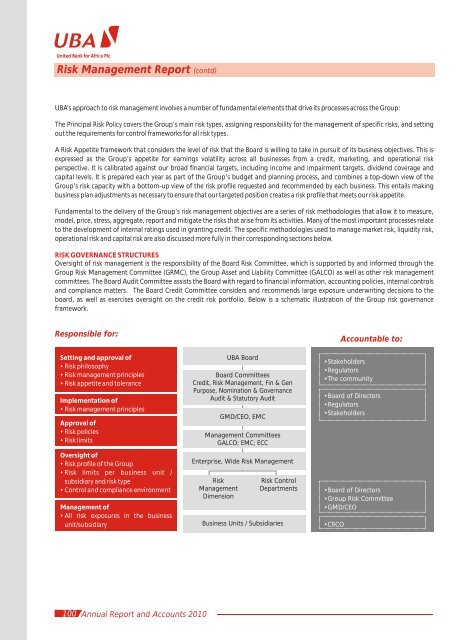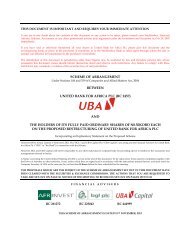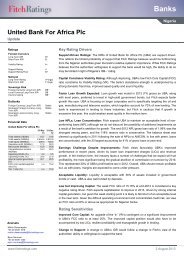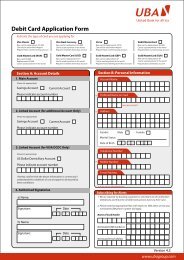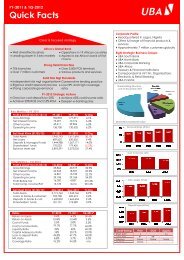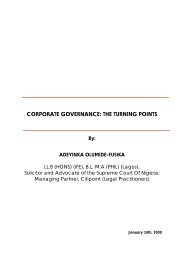2010 Annual Report and Financial Statements - UBA Plc
2010 Annual Report and Financial Statements - UBA Plc
2010 Annual Report and Financial Statements - UBA Plc
Create successful ePaper yourself
Turn your PDF publications into a flip-book with our unique Google optimized e-Paper software.
United Bank for Africa <strong>Plc</strong>Risk Management <strong>Report</strong> (contd)<strong>UBA</strong>’s approach to risk management involves a number of fundamental elements that drive its processes across the Group:The Principal Risk Policy covers the Group’s main risk types, assigning responsibility for the management of specific risks, <strong>and</strong> settingout the requirements for control frameworks for all risk types.A Risk Appetite framework that considers the level of risk that the Board is willing to take in pursuit of its business objectives. This isexpressed as the Group’s appetite for earnings volatility across all businesses from a credit, marketing, <strong>and</strong> operational riskperspective. It is calibrated against our broad financial targets, including income <strong>and</strong> impairment targets, dividend coverage <strong>and</strong>capital levels. It is prepared each year as part of the Group’s budget <strong>and</strong> planning process, <strong>and</strong> combines a top-down view of theGroup’s risk capacity with a bottom-up view of the risk profile requested <strong>and</strong> recommended by each business. This entails makingbusiness plan adjustments as necessary to ensure that our targeted position creates a risk profile that meets our risk appetite.Fundamental to the delivery of the Group’s risk management objectives are a series of risk methodologies that allow it to measure,model, price, stress, aggregate, report <strong>and</strong> mitigate the risks that arise from its activities. Many of the most important processes relateto the development of internal ratings used in granting credit. The specific methodologies used to manage market risk, liquidity risk,operational risk <strong>and</strong> capital risk are also discussed more fully in their corresponding sections below.RISK GOVERNANCE STRUCTURESOversight of risk management is the responsibility of the Board Risk Committee, which is supported by <strong>and</strong> informed through theGroup Risk Management Committee (GRMC), the Group Asset <strong>and</strong> Liability Committee (GALCO) as well as other risk managementcommittees. The Board Audit Committee assists the Board with regard to financial information, accounting policies, internal controls<strong>and</strong> compliance matters. The Board Credit Committee considers <strong>and</strong> recommends large exposure underwriting decisions to theboard, as well as exercises oversight on the credit risk portfolio. Below is a schematic illustration of the Group risk governanceframework.Responsible for:Setting <strong>and</strong> approval of Risk philosophy Risk management principles Risk appetite <strong>and</strong> toleranceImplementation of Risk management principlesApproval of Risk policies Risk limitsOversight of Risk profile of the Group Risk limits per business unit /subsidiary <strong>and</strong> risk type Control <strong>and</strong> compliance environmentManagement of All risk exposures in the businessunit/subsidiary<strong>UBA</strong> BoardBoard CommitteesCredit, Risk Management, Fin & GenPurpose, Nomination & GovernanceAudit & Statutory AuditGMD/CEO, EMCManagement CommitteesGALCO; EMC; ECCEnterprise, Wide Risk ManagementRiskManagementDimensionRisk ControlDepartmentsBusiness Units / SubsidiariesAccountable to:StakeholdersRegulatorsThe communityBoard of DirectorsRegulatorsStakeholdersBoard of DirectorsGroup Risk CommitteeGMD/CEOCRCO100<strong>Annual</strong> <strong>Report</strong> <strong>and</strong> Accounts <strong>2010</strong>


